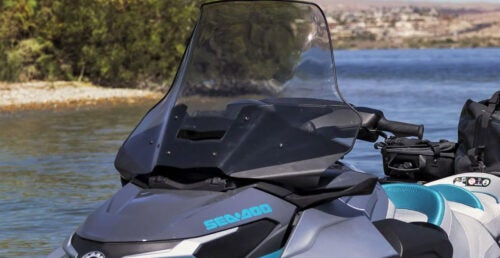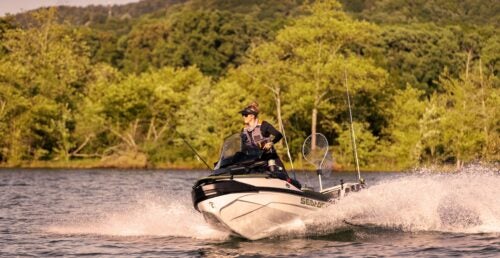Meet the New 2017 Yamaha EX
A worthy challenger to the Sea-Doo Spark emerges
Yamaha began its 2017 product reveal hinting that what members of the boating press were about to see would be new models targeted at those segments where the competition was strongest. Company reps then wasted no time showing the proof. Amongst the offerings coming from Yamaha for the ’17 season are an affordable entry-level model that is certain to go head-to-head with Sea-Doo’s Spark…and a powerful race-inspired craft that seems an inevitable contender to Sea-Doo’s RXP-X 300.
Jumping On the “Rec-Lite” Bandwagon
Until now, Yamaha had resisted entry into the so-called “Rec Lite” category, that smaller, more affordable niche practically defined by the Spark. Instead, the brand continued to make a good argument for the existing V1 series, noting the perennial best-selling design (this was the VX line until just recently) competed quite well on price given most Spark consumers optioned up to a bigger engine and three-passenger capacity. For 2017, however, the company has made the bold move to retire the popular V1 design and allow the recently refashioned VX move to a more midrange positioning. That leaves the door open for the all-new EX platform, a three-model series that is lighter, shorter, and more affordable than any three-passenger craft the brand has ever produced.

Given the competition, the EX’s specs are impressive. At 123.2” in length, the craft is a true three-passenger hauler, and has the capabilities – touring, towing, etc – to match. Capacities are also competitive. Total storage measures in at 7.7 gallons, split between a deep, water-bottle-friendly glovebox, shallow bow tub, and under-seat nook. Fuel capacity is 13.5 gallons. Yamaha also forged the EX from the same SMC (sheet molding compound) process at the core of all WaveRunners. As to the ride, it’s a throwback, double-duty. With your weight in the right place you can predictably carve a turn with precision, but switch it up and you can spin and power slide the hull with old-school flair.

As to the engine below the saddle, it’s the 1,049cc TR-1 that Yamaha introduced last year, although tweaks have been made to the exhaust manifold, muffler, and powertrain. Yamaha claims the engine is 14% more fuel-efficient than the Spark, and with the larger fuel capacity, offers 47% better range. Notably, it also produces 100 hp, which propelled the boat to a 50 mph top speed during my August test ride in Atlanta while displaying impressive acceleration and midrange power.

The EX will come in three variations, starting at $6,599 for the base version without reverse. Mechanical reverse is added to the EX Sport ($7,599), along with a reboarding step, mirrors, and more complex graphics package. The EX Deluxe ($8,599) takes things a step further, most notably adding RiDE along with metallic paint and a two-tone cut-and-sew-style saddle.
Return of the GP
The other big news is the retirement of the FZR/FZS series and the return of one of the most iconic names in Yamaha history…the GP.

Why flashback to a name long ago retired? Because the new GP1800 ($13,999) “is that good,” boasted Yamaha reps. Indeed, my initial ride on the craft revealed a hard-charging model with exceptional handling that is bound to be an instant contender on the race course.

The GP1800 shares the race-honed VXR hull, but that hull is now fabricated from Yamaha’s lighter weight NanoXCel 2 hull material. Into that lighter weight platform Yamaha chose to place the Super Vortex High Output (SVHO) supercharged, 1,812cc engine. With greater torque than any other Yamaha mill, this is the same engine that has brought Yamaha much success on the race course, and is now even more potent thanks to the improved power-to-weight ratio. My full review will be up in the coming weeks, but for now let’s just say this craft isn’t for the casual rider…and if you want to push it to its limits, you better hit the gym. This boat’s got power and agility to match. Or as Yamaha put it, the “heart of a lion…with the nimbleness of a gazelle.”

Though clearly designed for aggressive riders, the GP1800 includes Yamaha’s award-winning RiDE technology. Apparently even race types benefit from good manners around the dock or ramp.
FX Limited, SHO Engine Retirement
Yamaha’s final “new” announcement is the introduction of the FX Cruiser SVHO Limited ($16,899). Based on the popular FX Cruiser SVHO, the Limited is highlighted by a watersports accessory package similar to that introduced on the VX Limited last season. In addition to the FX Cruiser’s standard RiDE, Cruise Assist and No Wake Mode, the Limited package includes unique colors and graphics, “enhanced” Yamaha logo, 12V plug for electronics, solar battery charger, and a watersports-oriented tube, towrope, tube inflator, and tube holder to bring that inflatable along for the ride without compromising passenger space.
Completely gone from the WaveRunner lineup? The aforementioned FZR/FZS, as well as all SHO engine models and the three-passenger VXS. Returning models include the VX, VX Deluxe, VX Cruiser, VX Limited, VX Cruiser HO, VXR, FX HO, FX Cruiser HO, FX SVHO and FX Cruiser SVHO. The SuperJet also returns for “competition-use” only.
Get PersonalWatercraft.com in your Inbox!
Like PersonalWatercraft.com on Facebook
Comments
Most Popular

Remembering the Sea-Doo XP

2025 Yamaha JetBlaster PRO 2-Up Review

2024 Yamaha GP HO Review

2024 Kawasaki Jet Ski STX 160X Review

2017 Kawasaki Jet Ski Ultra 310LX Review










































 Your Privacy Choices
Your Privacy Choices